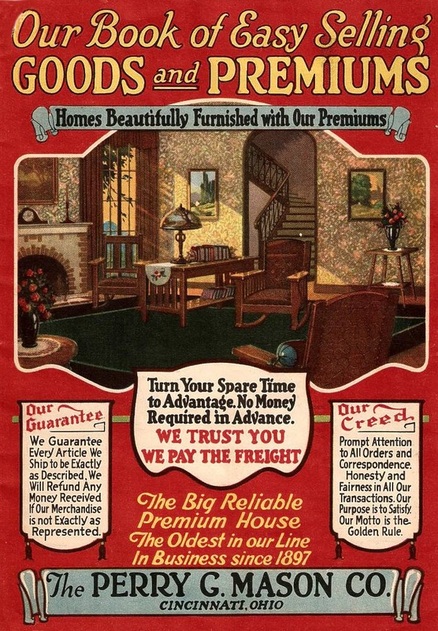Perry G. Mason (not the lawyer) - mail order, 1925 style.
|
The Perry G. Mason Co. of Cincinnati, Ohio ran a mail order business much like the more well-known Lee Manufacturing of Chicago. As far as we know, this is the first time that Mason's catalogues have been shown online to Carnival Glass collectors.
Judging by the image of Mason's business premises (left), it was on a smaller scale than Lee. The business model was however the same: they used agents all around the country to take mail order catalogues to customers, with rewards of discounted assortments, "free" gifts and premiums. Just like Lee Manufacturing, Mason was promoting a comfortable and immaculately furnished lifestyle! Also like Lee, Carnival Glass featured prominently in the mail order offerings from Mason, and in this catalogue from 1925 we have a huge selection of Carnival from Fenton and Imperial. However, before we take a look at the Carnival Glass that was on offer in the catalogue, just take a moment to look at the "Beautifully Furnished" room that was illustrated on the cover (left). In the very centre is a table lamp with a very distinctive shape. We were delighted to hear from glass collector, Kyle Penning, who wrote to us after seeing this catalogue here on our website. Kyle told us that he has this very lamp, explaining that the lamp base was made by Pittsburgh Lamp Base and Glass Co and that the painted shades are often a little different on each lamp. Kyle added that he also collects antique lamps and we are delighted to be able to show you his lamp here. The lamp base was made by Pittsburgh Lamp Base and Glass Co.
Picture is courtesy Kyle Penning. |
Carnival Glass offered in the 1925 catalogue - Imperial and Fenton.
On the page above, we see a set of Imperial Octagon goblets (one of Imperial's most produced patterns*);
a Fenton Holly bowl in a "bride's basket" wire holder; and a Fenton Orange Tree jelly, now called a sundae dish.
a Fenton Holly bowl in a "bride's basket" wire holder; and a Fenton Orange Tree jelly, now called a sundae dish.
* Imperial's original name for Octagon (their pattern #505) was "The Bellaire". In a separate article, we tell the story of this pattern from its launch in 1913 through to its Revival in the 1960s-1980s, as well as the various "look-alike" patterns. Read it here: Imperial's Octagon - The Story Behind The Glass
|
Fenton's Butterfly and Berry** sugar, creamer and a large sized footed berry
and a Fenton Fine Rib vase. The open "sugar" being offered was actually the spooner in the table set, not the sugar which would have had a covered top. Fenton also made a covered butter in their table set, so was it just too big a problem to include covered pieces in this Fenton assortment? |
Imperial and Fenton Carnival Glass, and what seems like an iridescent stretch glass bowl on a black plinth. The Imperial "Mayonnaise bowl" is Pillar Flute. Beneath it is a magnificent Mikado comport - note the higher price. Note also that the black plinth was described as having a dual purpose - turn it upside down and it could be used as an ashtray.
|
** Fenton's Butterfly and Berry pattern had one of the longest Carnival Glass production runs that we know of - being made initially by Fenton in Classic Carnival for almost 30 years, then again by Fenton in their Revival era Carnival, and also being reproduced by an unknown maker in Korea!
Here is the story: The Enduring Butterfly and Berry
Here is the story: The Enduring Butterfly and Berry
|
Although the Carnival Glass items above were all offered for the customer to purchase, an essential part of the catalogue, and the mail order sales methods was the inclusion of a selection of items offered as gifts and as "premiums". The set of Imperial's Open Rose "berry or salad" set, below left, was shown as a "Special Extra Present". And how did the customer qualify? Simply if they spent $10 on orders from the catalogue! |
Above, on the right is a truly spectacular array of a 26-piece set of Imperial pieces - mainly Lustre Rose / Open Rose*** (bowls, water set and table set), which intriguingly has been matched with a set of (Imperial) Grape goblets. The set, described as "one of the most beautiful and popular of all the modern glassware designs", was offered as a "premium" for the agent with a $15 order - now, that was some sales incentive!
*** By convention today, Carnival collectors call the collar based bowls Open Rose, all other pieces being called Lustre Rose. However, as is clear from this selection, they were the same pattern, all part of the same design. In fact, Imperial originally called the pattern range “American Beauties” or “American Beauty Roses”. It was introduced in Classic Carnival in around 1911 or 1912, and Carnival production continued into the Revival period ... and was copied by other makers. Read the full story of this pattern here: A Rose By Any Other Name - Imperial's American Beauty Roses
*** By convention today, Carnival collectors call the collar based bowls Open Rose, all other pieces being called Lustre Rose. However, as is clear from this selection, they were the same pattern, all part of the same design. In fact, Imperial originally called the pattern range “American Beauties” or “American Beauty Roses”. It was introduced in Classic Carnival in around 1911 or 1912, and Carnival production continued into the Revival period ... and was copied by other makers. Read the full story of this pattern here: A Rose By Any Other Name - Imperial's American Beauty Roses







